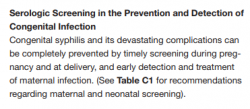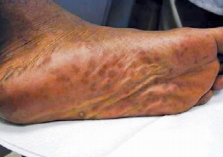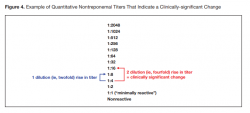Syphilis Monograph: “What you didn’t know, you needed to know about syphilis.”
This is the second installment of the “Fighting STDs Together: A PTC Series,” a collaboration between NNPTC and NCSD, highlighting their work with PCHD recipients. This week’s article highlights the collaboration between NYC PTC and NYC DOHMH for the Syphilis Monograph in response to rising syphilis rates.

Welcome to “Fighting STDs Together: A PTC Series.” This series highlights the pivotal work between PCHD grant recipients. The NNPTC consists of eight regional PTCs, each serving a specific area of the US.
Background & CDC Data
Babies are dying of a completely preventable and curable disease…
And according to Dr. Susan Blank, Assistant Commissioner and Director of the Bureau of STI’s at the New York City Health Department and Mental Hygiene (DOHMH), the numbers are frightening. “In New York City, the number of congenital syphilis cases increased 186% between 2017 and 2018.” New York City is not alone in its fight against syphilis according to the CDC’s 2017 Sexually Transmitted Disease Surveillance Report, congenital syphilis is increasing nationwide. “The rate of reported congenital syphilis has subsequently increased each year since 2012. In 2017, there were a total of 918 reported cases of congenital syphilis, including 64 syphilitic stillbirths and 13 infant deaths, and the national rate was 23.3 cases per 100,000 live births. This rate represents a 43.8% increase relative to 2016.” With the high rate of stillbirths and infant deaths, it tells STD experts that clinicians are possibly missing an opportunity to screen, diagnose and treat syphilis; those same experts agree that syphilis is one of the most complicated diseases to determine and training is key to decreasing the rates.

While the rates of congenital syphilis are alarming, women of reproductive age are not the only population health departments and STD experts are concerned about. “We wanted to highlight special populations, syphilis and HIV, congenital syphilis, and syphilis in pregnancy to really call attention to special populations in which we are seeing an unbelievable increase in the prevalence of these infections nationally,” says Dr. Natalie Neu, Medical Director of the New York City PTC. According to the CDC, MSM continue to account for the majority of syphilis cases. In 2017 over 57% of the reported syphilis cases were among MSM. Syphilis also disproportionality affects ethnic minorities, according to the same 2017 CDC report, “In 2017, the rate of reported P&S syphilis cases was highest among Blacks. The P&S syphilis rate among Blacks was 4.5 times the rate among Whites the rate among Native Hawaiians/Other Pacific Islanders (NHOPI) was 2.6 times the rate among Whites, the rate among Hispanics was 2.2 times the rate among Whites, the rate among American Indians/Alaska Natives (AI/AN) was 2.1 times the rate among Whites, and the rate among Asians was 0.8 times the rate among Whites.
Responding to the Crisis:
Three-Year Collaboration between the New York City PTC & New York City DOHMH
In 2016 the New York City PTC & the New York City Department of Health & Mental Hygiene (current PCHD recipient) began work on the the second edition of the Syphilis Monograph: The Diagnosis, Management and Prevention of Syphilis in an effort to respond to the growing concern of rising syphilis rates. Gowri Nagendra is the Director of the NYC PTC and says, “The reason we wanted to collaborate with the health department, was primarily because of their STD Clinic, and the patients and cases that they are seeing and bring together what we are seeing outside of an STD clinic from an academic, medical center standpoint. They had the clinical expertise, epidemiology, and the surveillance numbers, so it was a good blend to bring those two things together” From the perspective of the New York City DOHMH, the NYC PTC helped keep the project in perspective. “We have a long history of working with PTC they have been absolutely critical in coordinating making sure our focus didn’t get overly local. So we were assured that things would be useable for providers in other places,” says Dr. Blank.
After three years of collaboration, subject matter experts, coordination between two agencies, both federal and state clearance processes, and incorporating the 2015 CDC STD Treatment Guidelines into the document, the Syphilis Monograph: The Diagnosis, Management and Prevention of Syphilis is complete.

Dr. Thomas Cherneskie is the primary author of the Syphilis Monograph and is the Physician in charge of Chelsea Sexual Health Clinic for the New York City DOHMH. “Our intention was to try to pull together everything a clinician needs from case detection, treatment, partner management, and prevention of repeat infections, and to put it all into one document so they can reference it.” The collaboration team intended this publication to be useful for all levels of syphilis knowledge. “It’s designed to read from front to back if you have never come in contact with syphilis treatment or management, and you can still hone in on a few tables or algorithms to help clarify.” Dr. Blank agrees, “Syphilis has been increasing for last several years, nationally and NYC. Because the cases are diagnosed based on serology, it means that providers might be missing the symptomatic phase of diseases. So this is a great opportunity to remind them what these lesions look like, and provides guidance around understanding serology.”

Hyperpigmented dusky erythematous plantar macules in a patient with secondary syphilis. Source: Division of STD Prevention, National Center for HIV/AIDS, Viral Hepatitis, STD, and TB Prevention, Centers for Disease Control and Prevention. www.cdc.gov/std/syphilis/images.htm
Dr. Neu of the New York City PTC says it was important to her to make this document easy to read. “It’s so important to create education products that are user friendly, because people don’t have a lot of time. If you have a box that tells you the questions to ask, this is what it means to have a four-fold rise in titer with a graphic. That’s going to make a bigger impression than text.”

The Syphilis Monograph has been distributed widely through both the Regional PTCs and state departments of health. When asked, what would be your elevator speech to get clinicians to read and use the Syphilis Monograph, Dr. Blank responded, “Syphilis; it’s back, it’s still complicated, and here’s a resource to hopefully make this a little more straight forward.”